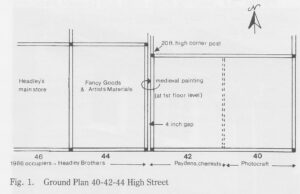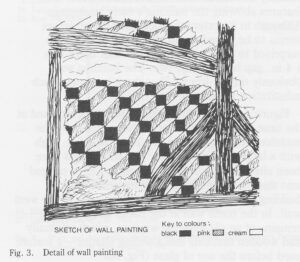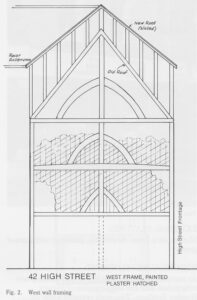Although these two shops appear to be continuous with No. 44, during the restoration of the latter it was discovered that there was a gap of four inches between the two buildings. This occurred at second floor level, the ground floor wall having been rebuilt in brick (Fig. 1).



External Features:
Front Elevation: Modern shop fronts.
First Floor: Red brick with I8th century sash windows.
Second Floor: Above, a white-painted wooden stringcourse. Above this, red hanging tiles on the right and red mathematical tiles on the left.
Roof: slated.
The two shops are structurally one building. During the refurbishment of the neighbouring shop, No. 44, the west wall of No. 42 was exposed to reveal the timber framing. This appears to be of late 15th-century or early 16th-century date. A most unusual discovery was the extensive wall painting carried out on the plaster infilling between the timbers (Fig. 3).
A photograph of this was sent to Mr. Clive Rouse, F.S.A., an authority on medieval wall paintings. He described the pattern as ‘perspective cube’, and wrote that this was rarely seen in domestic buildings. He quoted examples which he had seen in several churches in other parts of the country. As the painting was unlikely to have been carried out on an exterior wall, this poses the question as to whether the building had a further section on the ground now occupied by No. 44. If so, was that part destroyed by a fire? We have no records of such a fire.
It should be noted, however, that the gap between the buildings was sufficient to preserve the wall painting. A selection of the painted plaster has been preserved, mounted and exhibited in Chapel Mews at the rear of Headley Brothers’ store.
Briscall W., 1987, Discovering Ashford’s Old Buildings, Ashford, LRB Historical Publications
